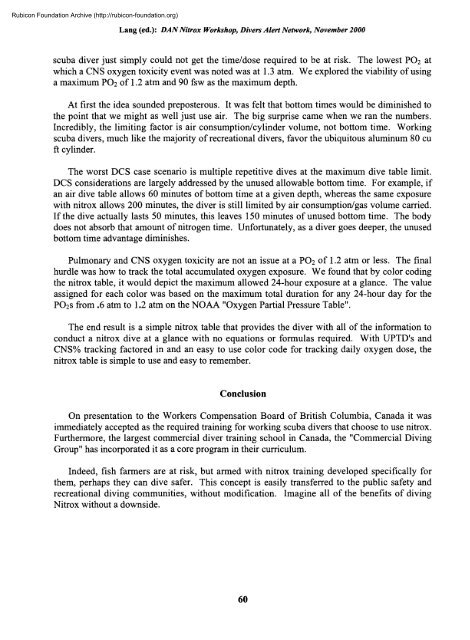Nitrox workshop dings - Divers Alert Network
Nitrox workshop dings - Divers Alert Network
Nitrox workshop dings - Divers Alert Network
Create successful ePaper yourself
Turn your PDF publications into a flip-book with our unique Google optimized e-Paper software.
Rubicon Foundation Archive (http://rubicon-foundation.org)Lang (ed.): DAN <strong>Nitrox</strong> Workshop, <strong>Divers</strong> <strong>Alert</strong> <strong>Network</strong>, November 2000scuba diver just simply could not get the time/dose required to be at risk. The lowest PO2 atwhich a CNS oxygen toxicity event was noted was at 1.3 atm. We explored the viability of usinga maximum PO2 of 1.2 atm and 90 fsw as the maximum depth.At first the idea sounded preposterous. It was felt that bottom times would be diminished tothe point that we might as well just use air. The big surprise came when we ran the numbers.Incredibly, the limiting factor is air consumption/cylinder volume, not bottom time. Workingscuba divers, much like the majority of recreational divers, favor the ubiquitous aluminum 80 cuft cylinder.The worst DCS case scenario is multiple repetitive dives at the maximum dive table limit.DCS considerations are largely addressed by the unused allowable bottom time. For example, ifan air dive table allows 60 minutes of bottom time at a given depth, whereas the same exposurewith nitrox allows 200 minutes, the diver is still limited by air consumption/gas volume carried.If the dive actually lasts 50 minutes, this leaves 150 minutes of unused bottom time. The bodydoes not absorb that amount of nitrogen time. Unfortunately, as a diver goes deeper, the unusedbottom time advantage diminishes.Pulmonary and CNS oxygen toxicity are not an issue at a PO2 of 1.2 atm or less. The finalhurdle was how to track the total accumulated oxygen exposure. We found that by color codingthe nitrox table, it would depict the maximum allowed 24-hour exposure at a glance. The valueassigned for each color was based on the maximum total duration for any 24-hour day for thePO 2 s from .6 atm to 1.2 atm on the NOAA "Oxygen Partial Pressure Table".The end result is a simple nitrox table that provides the diver with all of the information toconduct a nitrox dive at a glance with no equations or formulas required. With UPTD's andCNS% tracking factored in and an easy to use color code for tracking daily oxygen dose, thenitrox table is simple to use and easy to remember.ConclusionOn presentation to the Workers Compensation Board of British Columbia, Canada it wasimmediately accepted as the required training for working scuba divers that choose to use nitrox.Furthermore, the largest commercial diver training school in Canada, the "Commercial DivingGroup" has incorporated it as a core program in their curriculum.Indeed, fish farmers are at risk, but armed with nitrox training developed specifically forthem, perhaps they can dive safer. This concept is easily transferred to the public safety andrecreational diving communities, without modification. Imagine all of the benefits of diving<strong>Nitrox</strong> without a downside.60
















